MGT300 Case Study: Evaluating Amazon's HR Practices and Impact
VerifiedAdded on 2023/06/04
|8
|2000
|293
Case Study
AI Summary
This case study examines Amazon's HR practices, focusing on the challenges related to employee satisfaction, engagement, and high turnover rates. The analysis highlights issues such as low pay, long hours, and a demanding work environment, contrasting Amazon's success with its treatment of employees. The study discusses HRM trends like employee surveys and feedback platforms (e.g., Amazon Connections) and emphasizes the need for a more employee-centered culture. It suggests that Amazon should prioritize positive reinforcement, improve communication, and involve HR representatives to address employee concerns. The recommendations emphasize the importance of fostering a transparent and respectful work environment to reduce turnover and increase overall organizational success. The analysis references relevant academic literature to support its findings and recommendations.

Amazon’s HR practices
Student’s name
Institutional Affiliation(s)
[9/19/2018]
Student’s name
Institutional Affiliation(s)
[9/19/2018]
Paraphrase This Document
Need a fresh take? Get an instant paraphrase of this document with our AI Paraphraser

Introduction: Amazon
Amazon is a thriving online business that has taken over North America. The company has
become a household name, with over tens of millions of customers it has outdone huge
competition, such as Walmart and is now known as the most valuable retailer in the U.S. This
has led to what has gone wrong at Amazon. Amazon has taken advantage of its success, and this
can be shown by the way their employees are treated. Instead of praising the employees of
Amazon for all their hard work put towards the business, they are being ridiculed and put in
competition with one another (Alas & Vanhala, 2013). Having over tens of thousands of workers
they can view employees as just a number, being easily disposable for the next person in line if
they can’t keep up with the workload. Only 15 percent of employees have managed to be able to
work at the company for more than five years. Amazon blinded by its huge success has forgotten
about their moral responsibility to follow a business code of ethics. They have pushed and
continue to drive many workers to their breaking point.
Challenges & Opportunities: Amazon
Amazon is a well-known global online retailer that has struggled since its inception with
employee satisfaction and engagement. Low pay, long hours, and high turnover rates have been
an ongoing dilemma for the organization. For potential hires the lack of work-life balance that
Amazon is known for can be a significant deterrent. “The New York Times recently released a
scathing report that highlighted the unpleasant work conditions for white-collar workers at
Amazon, the world’s largest online retailer. The report noted that new hires were encouraged to
work late, follow unreasonably high standards and sabotage co-workers through surreptitious
criticism to management,” (Allen & Turner, 2017).
Amazon is a thriving online business that has taken over North America. The company has
become a household name, with over tens of millions of customers it has outdone huge
competition, such as Walmart and is now known as the most valuable retailer in the U.S. This
has led to what has gone wrong at Amazon. Amazon has taken advantage of its success, and this
can be shown by the way their employees are treated. Instead of praising the employees of
Amazon for all their hard work put towards the business, they are being ridiculed and put in
competition with one another (Alas & Vanhala, 2013). Having over tens of thousands of workers
they can view employees as just a number, being easily disposable for the next person in line if
they can’t keep up with the workload. Only 15 percent of employees have managed to be able to
work at the company for more than five years. Amazon blinded by its huge success has forgotten
about their moral responsibility to follow a business code of ethics. They have pushed and
continue to drive many workers to their breaking point.
Challenges & Opportunities: Amazon
Amazon is a well-known global online retailer that has struggled since its inception with
employee satisfaction and engagement. Low pay, long hours, and high turnover rates have been
an ongoing dilemma for the organization. For potential hires the lack of work-life balance that
Amazon is known for can be a significant deterrent. “The New York Times recently released a
scathing report that highlighted the unpleasant work conditions for white-collar workers at
Amazon, the world’s largest online retailer. The report noted that new hires were encouraged to
work late, follow unreasonably high standards and sabotage co-workers through surreptitious
criticism to management,” (Allen & Turner, 2017).

The online retail industry is highly competitive, and Amazon has done well with the creation of
innovative products and customer service ideas that allow them to remain at the top of the online
food chain. Unfortunately, their HR practices have also caused them to have a poor reputation
among potential employees, a reputation that could cost them current and future talent which
would allow their competitors a hiring advantage as new talent enter the workforce. “Today,
society and business are witnessing an unprecedented change in an increasingly global
marketplace, with many companies competing for talent. As organizations move forward into a
boundaryless environment, the ability to attract, engage, develop and retain talent will become
increasingly important,” (Allen, Turner, & Turner, 2018).
The development of a more employee-centered culture that enhances employee engagement
would benefit Amazon by increasing sales and revenue, allowing them to recruit more talent, and
assist with a reduction in employee turnover.
HRM Trends
To engage employees and create workplaces where employees feel values HR managers may
develop employee surveys. These surveys give management an opportunity to learn from the
employee’s perspective (DePamphilis, 2012). A well-developed survey will question employee
beliefs about the organization as a whole as well as their teammates and direct supervisors.
Surveys should be anonymous to encourage participation and honesty from the workforce of an
organization. “Research by Gallup shows that employee engagement is one of the key elements
of sales growth, which results in business and employee growth. According to Gallup, employee
engagement decreases workplace accidents by almost 50 percent and product or service defects
by over 40 percent. Even more astounding, turnover rates in high-pressure companies are
reduced by almost 70 percent,” (Dickmann, Brewster, & Sparrow, 2016).
innovative products and customer service ideas that allow them to remain at the top of the online
food chain. Unfortunately, their HR practices have also caused them to have a poor reputation
among potential employees, a reputation that could cost them current and future talent which
would allow their competitors a hiring advantage as new talent enter the workforce. “Today,
society and business are witnessing an unprecedented change in an increasingly global
marketplace, with many companies competing for talent. As organizations move forward into a
boundaryless environment, the ability to attract, engage, develop and retain talent will become
increasingly important,” (Allen, Turner, & Turner, 2018).
The development of a more employee-centered culture that enhances employee engagement
would benefit Amazon by increasing sales and revenue, allowing them to recruit more talent, and
assist with a reduction in employee turnover.
HRM Trends
To engage employees and create workplaces where employees feel values HR managers may
develop employee surveys. These surveys give management an opportunity to learn from the
employee’s perspective (DePamphilis, 2012). A well-developed survey will question employee
beliefs about the organization as a whole as well as their teammates and direct supervisors.
Surveys should be anonymous to encourage participation and honesty from the workforce of an
organization. “Research by Gallup shows that employee engagement is one of the key elements
of sales growth, which results in business and employee growth. According to Gallup, employee
engagement decreases workplace accidents by almost 50 percent and product or service defects
by over 40 percent. Even more astounding, turnover rates in high-pressure companies are
reduced by almost 70 percent,” (Dickmann, Brewster, & Sparrow, 2016).
⊘ This is a preview!⊘
Do you want full access?
Subscribe today to unlock all pages.

Trusted by 1+ million students worldwide
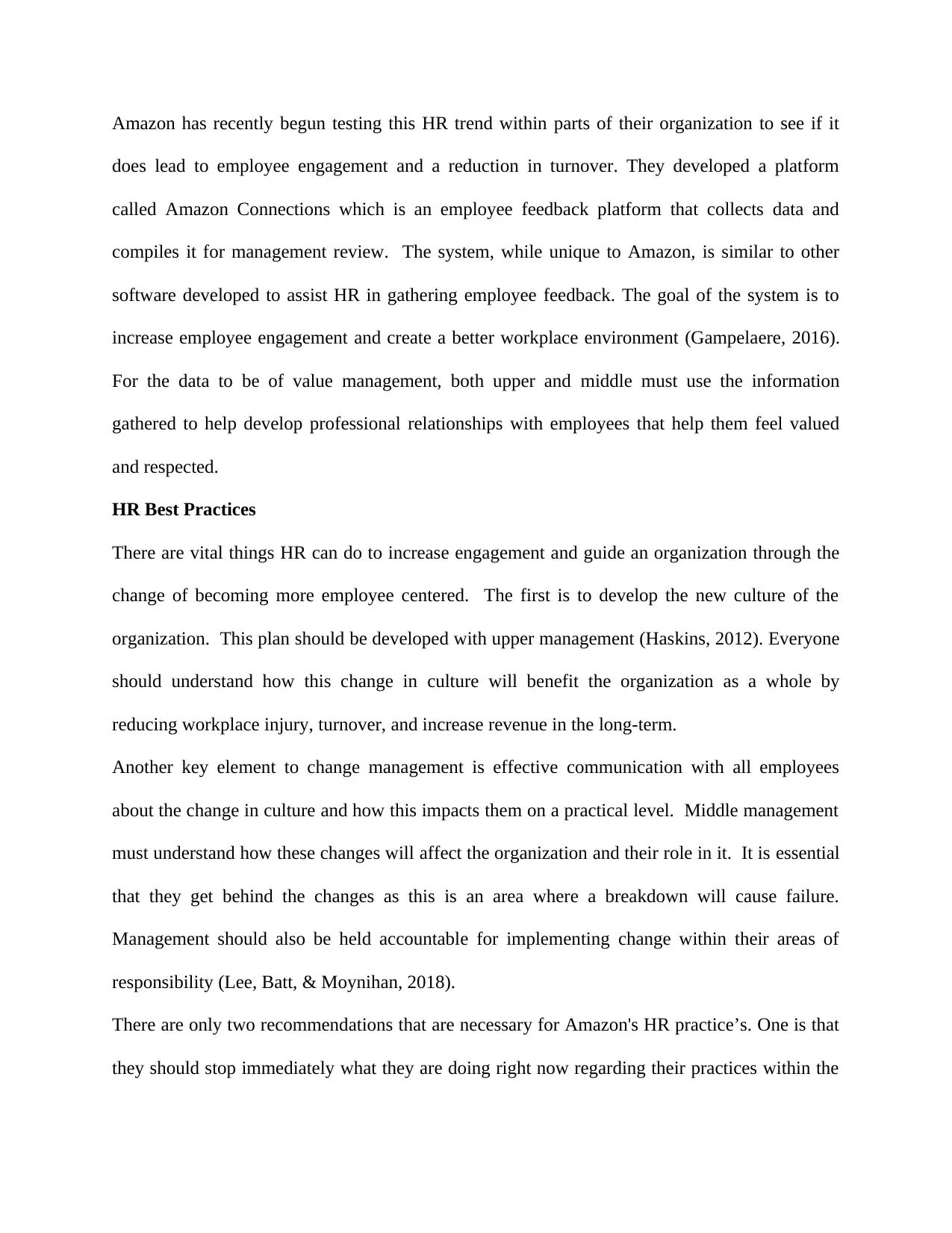
Amazon has recently begun testing this HR trend within parts of their organization to see if it
does lead to employee engagement and a reduction in turnover. They developed a platform
called Amazon Connections which is an employee feedback platform that collects data and
compiles it for management review. The system, while unique to Amazon, is similar to other
software developed to assist HR in gathering employee feedback. The goal of the system is to
increase employee engagement and create a better workplace environment (Gampelaere, 2016).
For the data to be of value management, both upper and middle must use the information
gathered to help develop professional relationships with employees that help them feel valued
and respected.
HR Best Practices
There are vital things HR can do to increase engagement and guide an organization through the
change of becoming more employee centered. The first is to develop the new culture of the
organization. This plan should be developed with upper management (Haskins, 2012). Everyone
should understand how this change in culture will benefit the organization as a whole by
reducing workplace injury, turnover, and increase revenue in the long-term.
Another key element to change management is effective communication with all employees
about the change in culture and how this impacts them on a practical level. Middle management
must understand how these changes will affect the organization and their role in it. It is essential
that they get behind the changes as this is an area where a breakdown will cause failure.
Management should also be held accountable for implementing change within their areas of
responsibility (Lee, Batt, & Moynihan, 2018).
There are only two recommendations that are necessary for Amazon's HR practice’s. One is that
they should stop immediately what they are doing right now regarding their practices within the
does lead to employee engagement and a reduction in turnover. They developed a platform
called Amazon Connections which is an employee feedback platform that collects data and
compiles it for management review. The system, while unique to Amazon, is similar to other
software developed to assist HR in gathering employee feedback. The goal of the system is to
increase employee engagement and create a better workplace environment (Gampelaere, 2016).
For the data to be of value management, both upper and middle must use the information
gathered to help develop professional relationships with employees that help them feel valued
and respected.
HR Best Practices
There are vital things HR can do to increase engagement and guide an organization through the
change of becoming more employee centered. The first is to develop the new culture of the
organization. This plan should be developed with upper management (Haskins, 2012). Everyone
should understand how this change in culture will benefit the organization as a whole by
reducing workplace injury, turnover, and increase revenue in the long-term.
Another key element to change management is effective communication with all employees
about the change in culture and how this impacts them on a practical level. Middle management
must understand how these changes will affect the organization and their role in it. It is essential
that they get behind the changes as this is an area where a breakdown will cause failure.
Management should also be held accountable for implementing change within their areas of
responsibility (Lee, Batt, & Moynihan, 2018).
There are only two recommendations that are necessary for Amazon's HR practice’s. One is that
they should stop immediately what they are doing right now regarding their practices within the
Paraphrase This Document
Need a fresh take? Get an instant paraphrase of this document with our AI Paraphraser
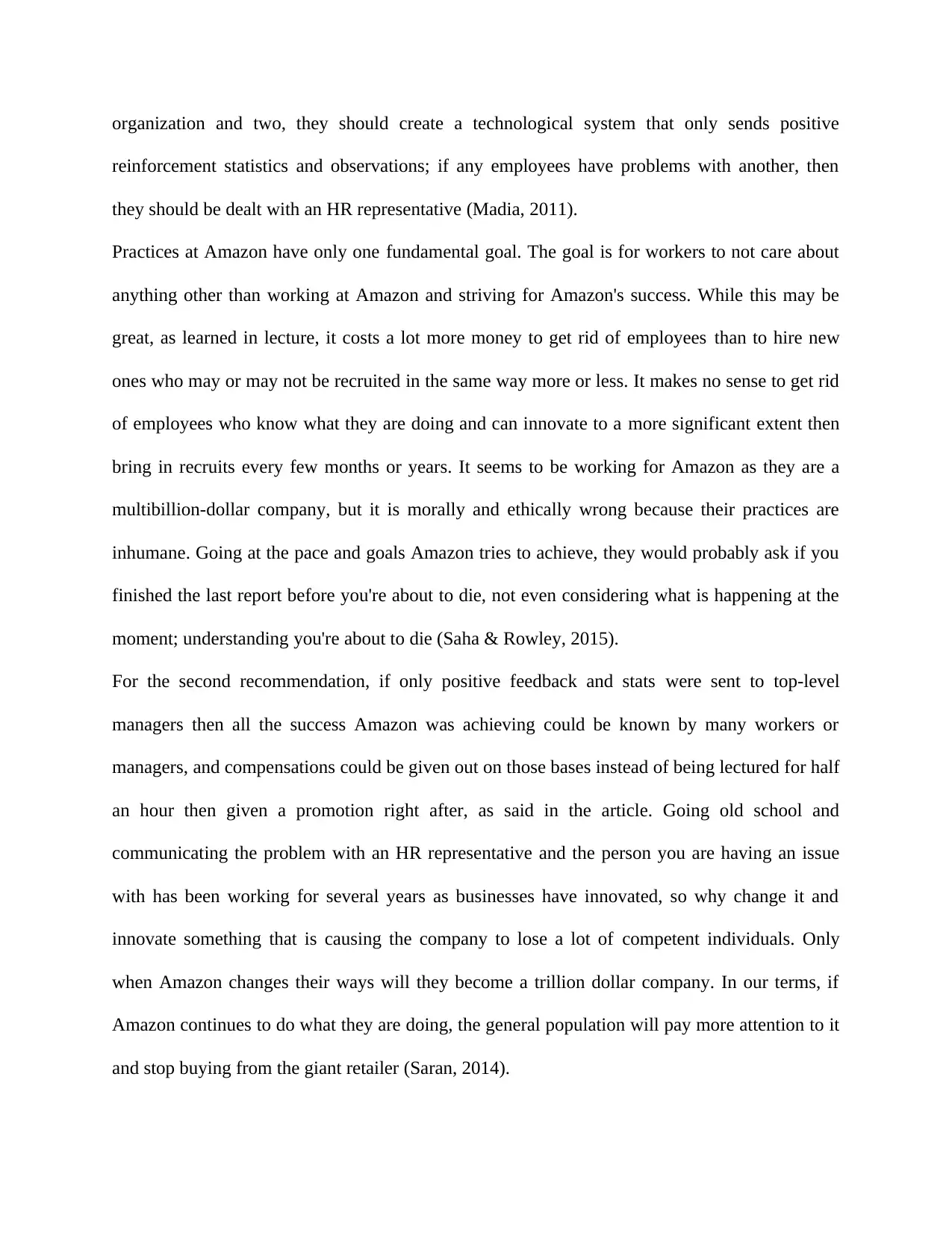
organization and two, they should create a technological system that only sends positive
reinforcement statistics and observations; if any employees have problems with another, then
they should be dealt with an HR representative (Madia, 2011).
Practices at Amazon have only one fundamental goal. The goal is for workers to not care about
anything other than working at Amazon and striving for Amazon's success. While this may be
great, as learned in lecture, it costs a lot more money to get rid of employees than to hire new
ones who may or may not be recruited in the same way more or less. It makes no sense to get rid
of employees who know what they are doing and can innovate to a more significant extent then
bring in recruits every few months or years. It seems to be working for Amazon as they are a
multibillion-dollar company, but it is morally and ethically wrong because their practices are
inhumane. Going at the pace and goals Amazon tries to achieve, they would probably ask if you
finished the last report before you're about to die, not even considering what is happening at the
moment; understanding you're about to die (Saha & Rowley, 2015).
For the second recommendation, if only positive feedback and stats were sent to top-level
managers then all the success Amazon was achieving could be known by many workers or
managers, and compensations could be given out on those bases instead of being lectured for half
an hour then given a promotion right after, as said in the article. Going old school and
communicating the problem with an HR representative and the person you are having an issue
with has been working for several years as businesses have innovated, so why change it and
innovate something that is causing the company to lose a lot of competent individuals. Only
when Amazon changes their ways will they become a trillion dollar company. In our terms, if
Amazon continues to do what they are doing, the general population will pay more attention to it
and stop buying from the giant retailer (Saran, 2014).
reinforcement statistics and observations; if any employees have problems with another, then
they should be dealt with an HR representative (Madia, 2011).
Practices at Amazon have only one fundamental goal. The goal is for workers to not care about
anything other than working at Amazon and striving for Amazon's success. While this may be
great, as learned in lecture, it costs a lot more money to get rid of employees than to hire new
ones who may or may not be recruited in the same way more or less. It makes no sense to get rid
of employees who know what they are doing and can innovate to a more significant extent then
bring in recruits every few months or years. It seems to be working for Amazon as they are a
multibillion-dollar company, but it is morally and ethically wrong because their practices are
inhumane. Going at the pace and goals Amazon tries to achieve, they would probably ask if you
finished the last report before you're about to die, not even considering what is happening at the
moment; understanding you're about to die (Saha & Rowley, 2015).
For the second recommendation, if only positive feedback and stats were sent to top-level
managers then all the success Amazon was achieving could be known by many workers or
managers, and compensations could be given out on those bases instead of being lectured for half
an hour then given a promotion right after, as said in the article. Going old school and
communicating the problem with an HR representative and the person you are having an issue
with has been working for several years as businesses have innovated, so why change it and
innovate something that is causing the company to lose a lot of competent individuals. Only
when Amazon changes their ways will they become a trillion dollar company. In our terms, if
Amazon continues to do what they are doing, the general population will pay more attention to it
and stop buying from the giant retailer (Saran, 2014).
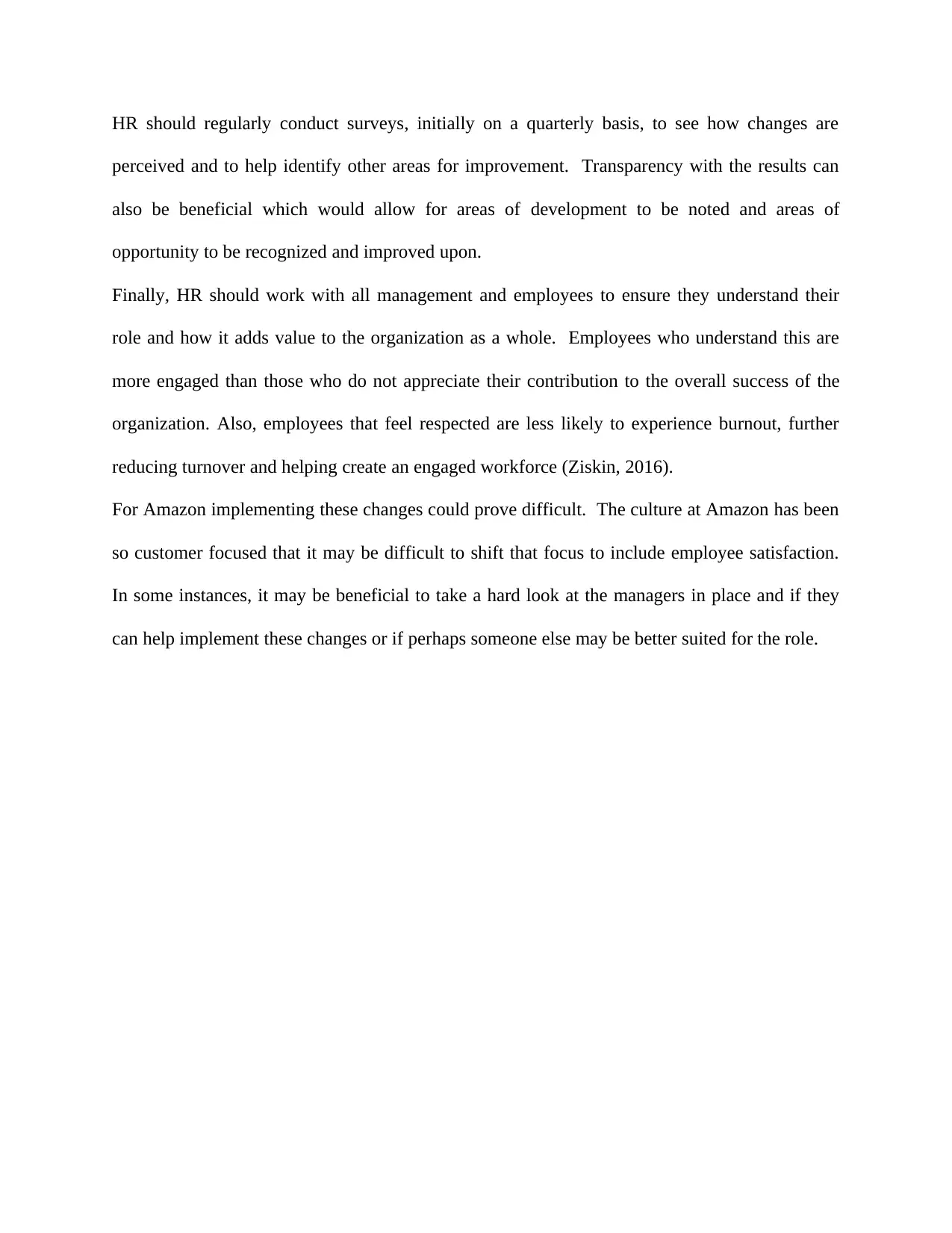
HR should regularly conduct surveys, initially on a quarterly basis, to see how changes are
perceived and to help identify other areas for improvement. Transparency with the results can
also be beneficial which would allow for areas of development to be noted and areas of
opportunity to be recognized and improved upon.
Finally, HR should work with all management and employees to ensure they understand their
role and how it adds value to the organization as a whole. Employees who understand this are
more engaged than those who do not appreciate their contribution to the overall success of the
organization. Also, employees that feel respected are less likely to experience burnout, further
reducing turnover and helping create an engaged workforce (Ziskin, 2016).
For Amazon implementing these changes could prove difficult. The culture at Amazon has been
so customer focused that it may be difficult to shift that focus to include employee satisfaction.
In some instances, it may be beneficial to take a hard look at the managers in place and if they
can help implement these changes or if perhaps someone else may be better suited for the role.
perceived and to help identify other areas for improvement. Transparency with the results can
also be beneficial which would allow for areas of development to be noted and areas of
opportunity to be recognized and improved upon.
Finally, HR should work with all management and employees to ensure they understand their
role and how it adds value to the organization as a whole. Employees who understand this are
more engaged than those who do not appreciate their contribution to the overall success of the
organization. Also, employees that feel respected are less likely to experience burnout, further
reducing turnover and helping create an engaged workforce (Ziskin, 2016).
For Amazon implementing these changes could prove difficult. The culture at Amazon has been
so customer focused that it may be difficult to shift that focus to include employee satisfaction.
In some instances, it may be beneficial to take a hard look at the managers in place and if they
can help implement these changes or if perhaps someone else may be better suited for the role.
⊘ This is a preview!⊘
Do you want full access?
Subscribe today to unlock all pages.

Trusted by 1+ million students worldwide
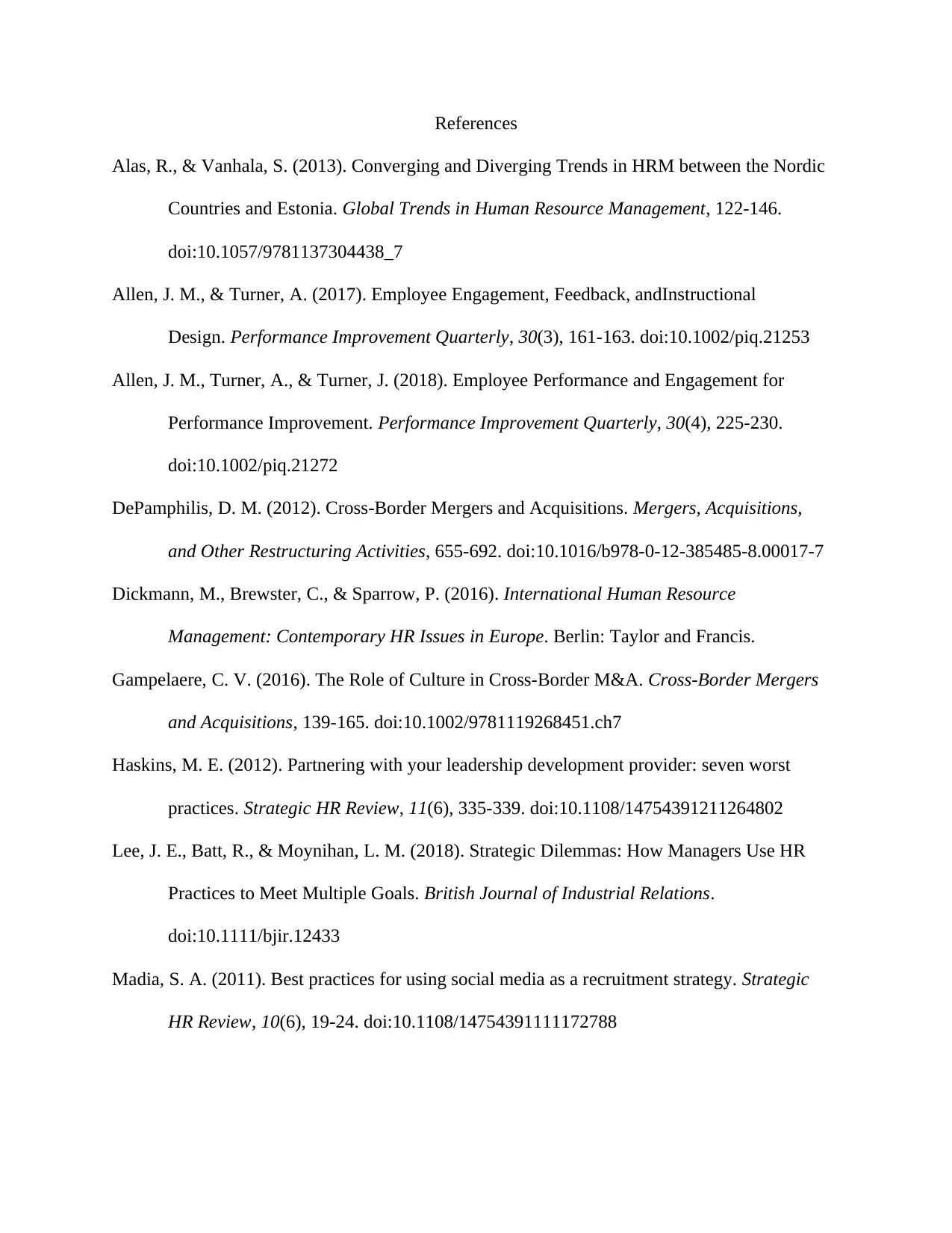
References
Alas, R., & Vanhala, S. (2013). Converging and Diverging Trends in HRM between the Nordic
Countries and Estonia. Global Trends in Human Resource Management, 122-146.
doi:10.1057/9781137304438_7
Allen, J. M., & Turner, A. (2017). Employee Engagement, Feedback, andInstructional
Design. Performance Improvement Quarterly, 30(3), 161-163. doi:10.1002/piq.21253
Allen, J. M., Turner, A., & Turner, J. (2018). Employee Performance and Engagement for
Performance Improvement. Performance Improvement Quarterly, 30(4), 225-230.
doi:10.1002/piq.21272
DePamphilis, D. M. (2012). Cross-Border Mergers and Acquisitions. Mergers, Acquisitions,
and Other Restructuring Activities, 655-692. doi:10.1016/b978-0-12-385485-8.00017-7
Dickmann, M., Brewster, C., & Sparrow, P. (2016). International Human Resource
Management: Contemporary HR Issues in Europe. Berlin: Taylor and Francis.
Gampelaere, C. V. (2016). The Role of Culture in Cross-Border M&A. Cross-Border Mergers
and Acquisitions, 139-165. doi:10.1002/9781119268451.ch7
Haskins, M. E. (2012). Partnering with your leadership development provider: seven worst
practices. Strategic HR Review, 11(6), 335-339. doi:10.1108/14754391211264802
Lee, J. E., Batt, R., & Moynihan, L. M. (2018). Strategic Dilemmas: How Managers Use HR
Practices to Meet Multiple Goals. British Journal of Industrial Relations.
doi:10.1111/bjir.12433
Madia, S. A. (2011). Best practices for using social media as a recruitment strategy. Strategic
HR Review, 10(6), 19-24. doi:10.1108/14754391111172788
Alas, R., & Vanhala, S. (2013). Converging and Diverging Trends in HRM between the Nordic
Countries and Estonia. Global Trends in Human Resource Management, 122-146.
doi:10.1057/9781137304438_7
Allen, J. M., & Turner, A. (2017). Employee Engagement, Feedback, andInstructional
Design. Performance Improvement Quarterly, 30(3), 161-163. doi:10.1002/piq.21253
Allen, J. M., Turner, A., & Turner, J. (2018). Employee Performance and Engagement for
Performance Improvement. Performance Improvement Quarterly, 30(4), 225-230.
doi:10.1002/piq.21272
DePamphilis, D. M. (2012). Cross-Border Mergers and Acquisitions. Mergers, Acquisitions,
and Other Restructuring Activities, 655-692. doi:10.1016/b978-0-12-385485-8.00017-7
Dickmann, M., Brewster, C., & Sparrow, P. (2016). International Human Resource
Management: Contemporary HR Issues in Europe. Berlin: Taylor and Francis.
Gampelaere, C. V. (2016). The Role of Culture in Cross-Border M&A. Cross-Border Mergers
and Acquisitions, 139-165. doi:10.1002/9781119268451.ch7
Haskins, M. E. (2012). Partnering with your leadership development provider: seven worst
practices. Strategic HR Review, 11(6), 335-339. doi:10.1108/14754391211264802
Lee, J. E., Batt, R., & Moynihan, L. M. (2018). Strategic Dilemmas: How Managers Use HR
Practices to Meet Multiple Goals. British Journal of Industrial Relations.
doi:10.1111/bjir.12433
Madia, S. A. (2011). Best practices for using social media as a recruitment strategy. Strategic
HR Review, 10(6), 19-24. doi:10.1108/14754391111172788
Paraphrase This Document
Need a fresh take? Get an instant paraphrase of this document with our AI Paraphraser
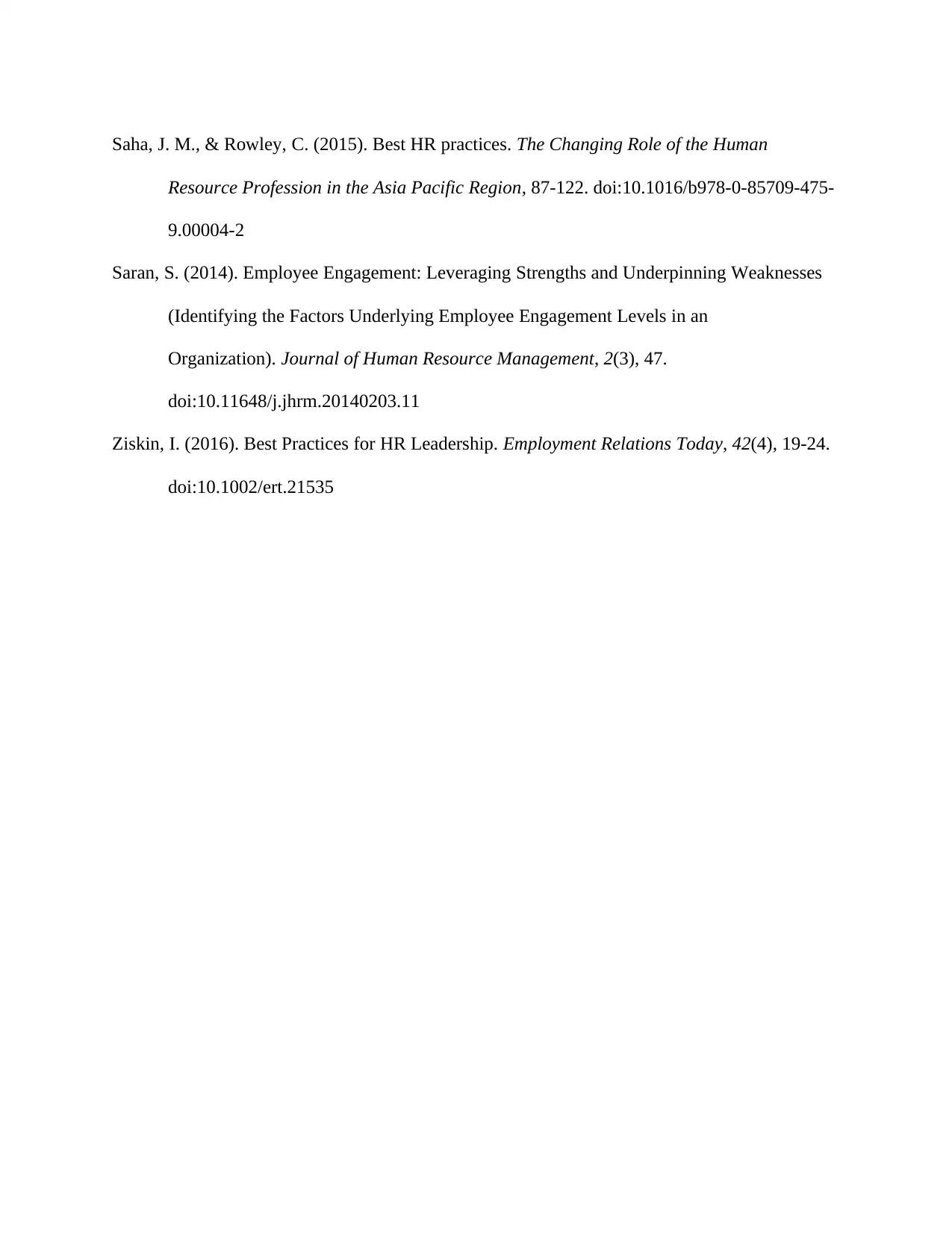
Saha, J. M., & Rowley, C. (2015). Best HR practices. The Changing Role of the Human
Resource Profession in the Asia Pacific Region, 87-122. doi:10.1016/b978-0-85709-475-
9.00004-2
Saran, S. (2014). Employee Engagement: Leveraging Strengths and Underpinning Weaknesses
(Identifying the Factors Underlying Employee Engagement Levels in an
Organization). Journal of Human Resource Management, 2(3), 47.
doi:10.11648/j.jhrm.20140203.11
Ziskin, I. (2016). Best Practices for HR Leadership. Employment Relations Today, 42(4), 19-24.
doi:10.1002/ert.21535
Resource Profession in the Asia Pacific Region, 87-122. doi:10.1016/b978-0-85709-475-
9.00004-2
Saran, S. (2014). Employee Engagement: Leveraging Strengths and Underpinning Weaknesses
(Identifying the Factors Underlying Employee Engagement Levels in an
Organization). Journal of Human Resource Management, 2(3), 47.
doi:10.11648/j.jhrm.20140203.11
Ziskin, I. (2016). Best Practices for HR Leadership. Employment Relations Today, 42(4), 19-24.
doi:10.1002/ert.21535
1 out of 8
Related Documents
Your All-in-One AI-Powered Toolkit for Academic Success.
+13062052269
info@desklib.com
Available 24*7 on WhatsApp / Email
![[object Object]](/_next/static/media/star-bottom.7253800d.svg)
Unlock your academic potential
Copyright © 2020–2025 A2Z Services. All Rights Reserved. Developed and managed by ZUCOL.




